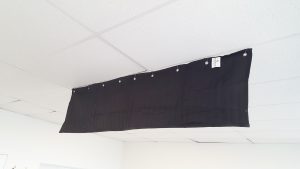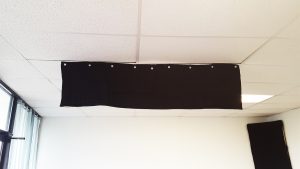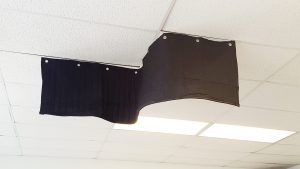Many people who are starting to set up their home recording studio often get confused on what is soundproofing, and what is acoustic treatment.
The materials and techniques used in soundproofing are very different from what needs to be used foracoustic room treatment. And, when you are preparing to set up your home recording studio, you need to understand the differences before shopping for soundproofing products. Understanding of basic principles of soundproofing will help you make right decisions, save you time and money, and a lot of headache down the road.
Definition of Soundproofing
In a nut shell, soundproofing means that the sound has to be stopped from leaking in or out of an enclosure. Soundproofing, in essence, is reducing the sound pressure between the source of sound that is generating the actual sound pressure and the receiver of the sound – such as a microphone or human ear.
For example: If a lawn mower or airplane passes by your home, it generates a pressure wave of a certain frequency. That wave travels to your house and will be heard and possibly physically felt, depending on the frequency generated. To keep those sounds out, a recording studio needs to be isolated from the outside world. Sound isolation works the same — both ways — so there’s no difference in the approach of keeping sound in or out.
However, don’t be misled. It is very hard to achieve a 100% sound isolation on a small budget. But, knowing the physics of sound and understanding how sound transmits can help to achieve the best sound isolation possible.
The Science Behind “Sound”
The science of sound might have sounded boring when you had to learn it in school, but now, when you are building your own recording studio, it has a very practical application.
So, what exactly is “sound” ?
Sound is a type of energy made by vibrations. Vibrating objects create a mechanical disturbance in the medium in which it is directly adjacent to. Usually, the medium is air. So sound is actually a pressure wave.
When an object vibrates, it causes movement in the surrounding particles. These particles bump into the particles close to them, which also make them vibrate — causing them to bump into more air particles. The energy of their interaction creates ripples of more dense (higher pressure) to less dense (lower pressure) air molecules, with pressures above and below the normal atmospheric pressure. When the molecules are pushed closer together, it is called compression; when they are pulled apart, it is called rarefaction.
The back and forth oscillation of pressure produces sound waves. The frequency of the waves depends on the frequency of the vibrations. This movement keeps going until it runs out of energy.
The other thing to consider is that a sound wave is a form of a traveling wave, in that the air molecules disturbed by the sound source are unlikely to be the ones hitting your eardrum, but transfer their energy to other neighboring molecules. These mechanical vibrations are able to travel through all forms of matter: gases, liquids, solids. Sound cannot travel through vacuum because there are no particles to transfer the sound energy.
In summary:
- For sound to be generated and transmitted something must be vibrating;
- Sound waves travel by passing energy form a particle to a particle;
- Sound dies out eventually when it loses its energy. (It happens due to friction in the air itself or in trying to move (vibrate) the barriers it encounters. Sound energy does not just disappear, but have to be spent on doing some work and while doing the work it is converted to heat. )
- Sound can be transmitted through anything that has particles air, wood, concrete etc. (not vacuum).
How to use that knowledge to soundproof a room, a door, sound booth or any type of soundproofing?
1 Since sound is transmitted by air you need to make an air tight enclosure, that does not let the sound waves in or out;
2 Because Sound energy can make particles in your enclosure vibrate and get through this way, you need to make it (a barrier) as heavy as possible. (Construct the barriers (walls) using materials that are hard to move, have a lot of mass and it take a lot of energy to get vibrating);
3 Because the sound waves can be transmitted through existing structural elements of the building ( like wall, floors, ceilings) you need to separate the vocal booth enclosure from other structural elements of the building it adjacent to, which may transmit the sound energy from the outside world.
Is soundproofing that simple?
This sounds pretty simple, isn’t it? In theory. But in practice you have to deal with materials that can achieve the level of isolation you require and the costs of those materials.
Theoretically one may suggest surrounding the room with a layer of vacuum, but that is probably for a Sci-Fi.
In real life you have to use what is available and it gets complicated.
This is where the secret is: What and How of soundproofing. What materials to use? How to install them?
Using mass for soundproofing
Although sound can’t escape directly from an airtight environment, its vibration energy causes the walls of the room to vibrate, and they in turn launch new sound waves. That is why it is important to make walls that would not move. And the heavier the walls, the more energy it requires to get them vibrating. So naturally, the simplest thing that can be done is to add mass to the walls.
But different materials have different sound transmission properties (see What is STC – Sound Transmission Class).
Brick is better than plywood, and then there are loss of materials like sand.
(For example, a given thickness of glass may transmit (let through) more sound energy than the same thickness and mass of sand, because the sand particles tend to lose more energy through friction between the individual particles.)
NOTE: As a rule of thumb, if the mass of a wall doubled (by doubling its thickness, for instance) amount of sound leakage will be reduced by 6 dB.
Using decoupling for soundproofing.
Separating the sound enclosure from structural elements of the building it’s adjacent to, (decoupling) helps to block structure-borne sound. Sound energy travels very efficiently, as mechanical vibrations, through wooden joists or steel girders. Special attention needs to be paid to floor supports as most unwanted energy gets injected into the floor.
NOTE: If sonic vibrations are injected into these components, they’ll bypass all soundproofing.
Sound frequencies and soundproofing.
Another issue that makes soundproofing complicated is that the sound waves have a range of frequencies and the isolation provided by a structure reduces with lower frequency. While high frequencies are easy to keep in or out, low frequencies are far more difficult to contain.
Since different frequencies have different wave length for every frequency above a certain, critical value, there’ll be an angle of incidence for which the wavelength within the material is equal to the wavelength of the sound incident upon the material, and when this occurs the attenuation drops significantly. This is why using layers of materials with different acoustic properties can help to improve soundproofing characteristics of a wall.
NOTE: The rule of thumb here is that for every octave drop in pitch the amount of sound isolation is halved.
Using air gap for cost effective soundproofing.
But, things are even more complex than this. Sheer increase in mass and thickness of the wall is not always feasible or cost effective. The best sound proofing method, which is used by most professional studios, is to build double walls with an air gap between them. The cushion of air between the walls separates energy from one wall to the other, and the wider the air gap, the better the isolation (most noticeable at low frequencies again).
NOTE: Unless the walls are separated by a considerable distance, the cushion of air between the walls couples energy from one wall to the other, reducing the isolation. But double wall structure will invariably perform significantly better than a single-layer barrier of similar mass, even if the air gap is only a few inches wide.
When soundproofing your voice over studio or recording room, combinations of factors must be considered. Doing your homework and understanding the science behind the sound will greatly help you to create a more successful home recording studio.





